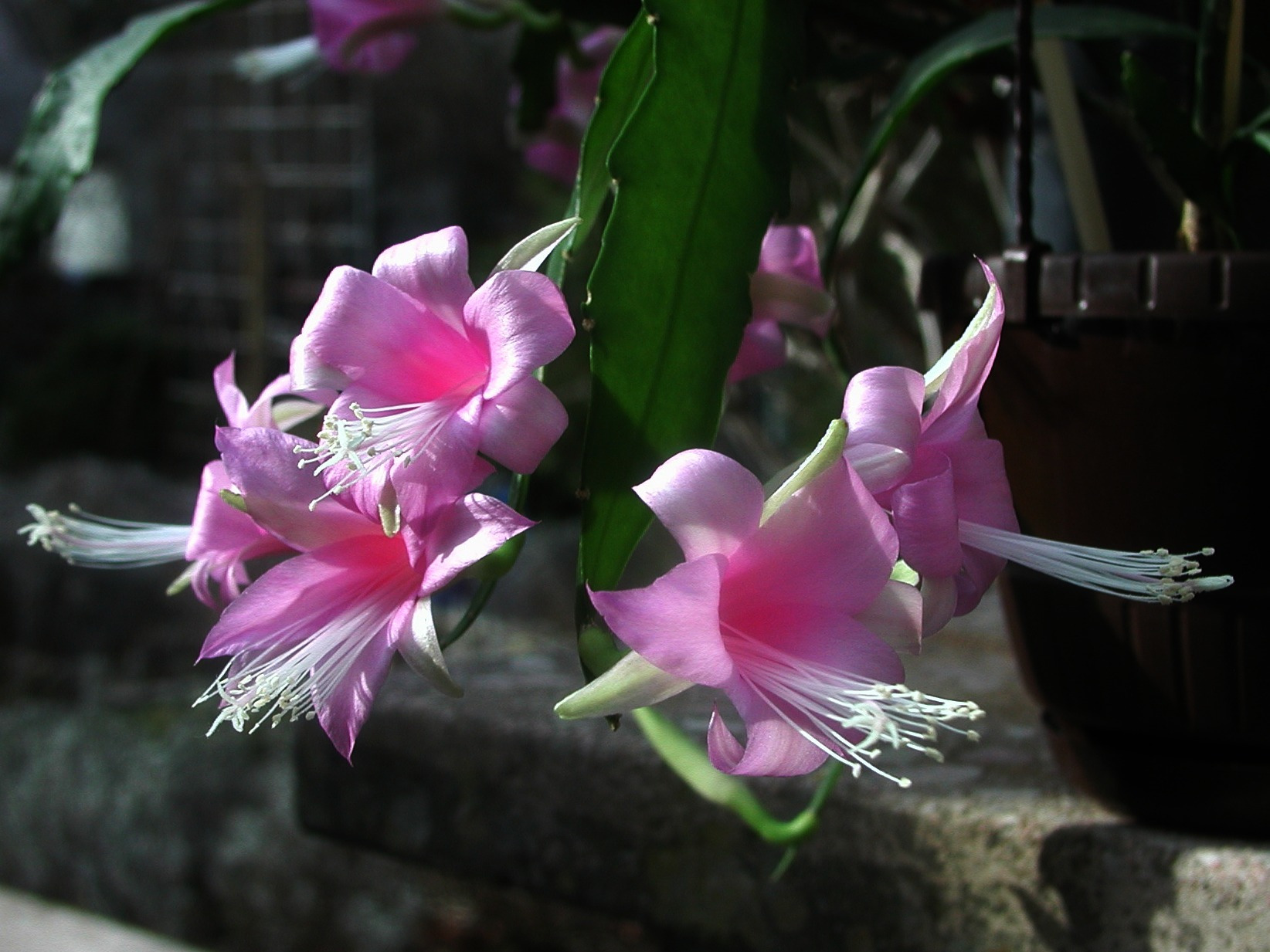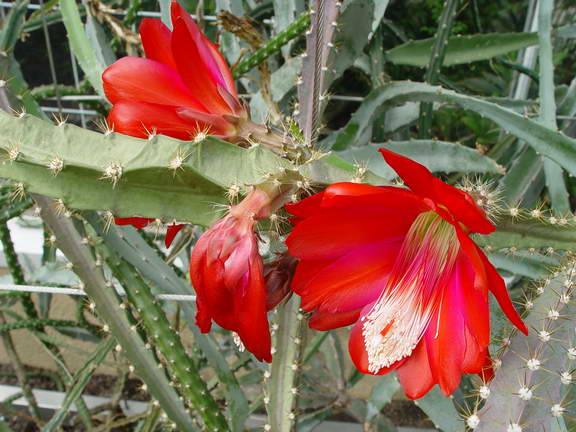|
Aporocactus
''Aporocactus'' is a genus of cacti in the tribe Hylocereeae native to Mexico. It used to be classified as a subgenus in ''Disocactus'', but according to molecular evidence, it should be excluded from ''Disocactus'' and treated as a separate genus Genus ( plural genera ) is a taxonomic rank used in the biological classification of living and fossil organisms as well as viruses. In the hierarchy of biological classification, genus comes above species and below family. In binomial nom .... Description It is an epiphytic genus growing on the branches of trees, but without parasitizing them. Occurs as drooping or creeping stems up to 60 cm with 6 ribs covered with many small thorns. Extant Species There are two species in the genus ''Aporocactus'': References External Links * * {{Taxonbar, from=Q2858521 Hylocereeae Cactoideae genera ... [...More Info...] [...Related Items...] OR: [Wikipedia] [Google] [Baidu] |
Aporocactus Martianus
''Aporocactus martianus'' (syn. ''Disocactus martianus'') is a species of cactus found in Oaxaca, Mexico. Description ''Disocactus martianus'' grows creeping, occasionally forming lithophytic with aerial roots. It is a species of fleshy, cylindrical suspended or creeping cactus with stems up to 1.5 meters long and up to 2.5 centimeters thick, sometimes with aerial roots, with 8 to 10 slightly wart-shaped ribs; 3 or 4 central pale brown spines up to 12 mm long and 6 to 20 radial spines are light yellowish and only 5 to 7 millimeters long. The bright red flowers are diurnal and produced in summer, 10 to 12 centimeters in diameter and a length of 5 to 7 centimeters. The flowers stay open for a couple of days. They are followed by globose fruits of green color and 2 cm in diameter. It is viviparous. File:Discocactus martianus pm1.jpg, Flowers side File:Disocactus martianus 362203.jpg, Flowers Taxonomy & Systematics It was first described as ''Cereus martianus'' in 1837 by Ludwig ... [...More Info...] [...Related Items...] OR: [Wikipedia] [Google] [Baidu] |
Aporocactus Flagelliformis
''Aporocactus flagelliformis'' (syn. ''Disocactus flagelliformis''), the rattail cactus, is a species of flowering plant in the cactus family Cactaceae, and is the most cultivated species in the genus ''Aporocactus''. Due to its ease of cultivation and attractive floral displays, it is often grown as an ornamental potted plant. Description Stems ascending, later prostrate or pendent, profusely branching at base, 1–2 m long or more, 8–24 mm thick; ribs 7-14, obtuse; margins ± tuberculate; areoles minute, whitish; internodes 4–8 mm; spines 8-20, 3-8 (-10) mm long, bristle-like, yellowish to brownish; epidermis green, later grayish. Flowers zygomorphic, 7–10 cm long, 2-4 (-7,5) cm wide, limb bilaterally symmetric, oblique, diurnal, open for 3–5 days, scentless; pericarpel greenish with acute bracteoles; receptacle 3 cm, long, curved just above pericarpel, bracteoles, brownish, acute; outer tepals linear-lanceolate, ± reflexed, 2–3 cm long, 6&nb ... [...More Info...] [...Related Items...] OR: [Wikipedia] [Google] [Baidu] |
Hylocereeae
The Hylocereeae are a tribe of cacti. Most are found in the tropical forests of Central and northern South America, and are climbers or epiphytes, unlike most cacti. The tribe includes between six and eight genera in different circumscriptions. The plants known as "epiphyllum hybrids" or "epiphyllums", widely grown for their flowers, are hybrids of species within this tribe, particularly ''Disocactus'', ''Pseudorhipsalis'' and ''Selenicereus'', less often ''Epiphyllum'', in spite of the common name. Description The members of the tribe are very variable in their morphology, especially when the terrestrial ''Acanthocereus'' is included. Many species form aerial roots. The hylocereoid clade (''Selenicereus'', ''Weberocereus'' and probably ''Aporocactus'') are mostly climbing or epiphytic, and have spiny ribbed stems. The phyllocactoid clade (''Epiphyllum'', ''Disocactus'', ''Kimnachia'' and ''Pseudorhipsalis'') are mainly epiphytic, and have spineless flattened leaf-like stems. F ... [...More Info...] [...Related Items...] OR: [Wikipedia] [Google] [Baidu] |
Disocactus
''Disocactus'' is a genus of epiphytic cacti in the tribe Hylocereeae found in Central America, the Caribbean and northern South America. It should not be confused with ''Discocactus'', which is a different genus. Species of ''Disocactus'' grow in tropical regions either on trees as epiphytes or on rocks as lithophytes. They have two distinct growth habits. Species such as '' D. phyllanthoides'' have stems which are round at the base but then become flattened and leaflike. Many of the cultivated plants known as epiphyllum hybrids or just epiphyllums are derived from crosses between species of ''Disocactus'' (rather than ''Epiphyllum'') and other genera in the Hylocereeae., p. 286 Description The species of the genus ''Disocactus'' grow as epiphytes or lithophytes and are shrubby, profusely branched, hanging, up to 3 m long. The shoots are ribbed or flattened, 3-angled or flattened, ribbon-like, 3–10 mm wide, remotely crenate and leaf-like. The main shoot, which rot ... [...More Info...] [...Related Items...] OR: [Wikipedia] [Google] [Baidu] |
Disocactus Flagelliformis1MABJ
''Disocactus'' is a genus of epiphytic cacti in the tribe Hylocereeae found in Central America, the Caribbean and northern South America. It should not be confused with ''Discocactus'', which is a different genus. Species of ''Disocactus'' grow in tropical regions either on trees as epiphytes or on rocks as lithophytes. They have two distinct growth habits. Species such as '' D. phyllanthoides'' have stems which are round at the base but then become flattened and leaflike. Many of the cultivated plants known as epiphyllum hybrids or just epiphyllums are derived from crosses between species of ''Disocactus'' (rather than ''Epiphyllum'') and other genera in the Hylocereeae., p. 286 Description The species of the genus ''Disocactus'' grow as epiphytes or lithophytes and are shrubby, profusely branched, hanging, up to 3 m long. The shoots are ribbed or flattened, 3-angled or flattened, ribbon-like, 3–10 mm wide, remotely crenate and leaf-like. The main shoot, which rot ... [...More Info...] [...Related Items...] OR: [Wikipedia] [Google] [Baidu] |
Disocactus Martianus 362203
''Disocactus'' is a genus of epiphytic cacti in the tribe Hylocereeae found in Central America, the Caribbean and northern South America. It should not be confused with ''Discocactus'', which is a different genus. Species of ''Disocactus'' grow in tropical regions either on trees as epiphytes or on rocks as lithophytes. They have two distinct growth habits. Species such as '' D. phyllanthoides'' have stems which are round at the base but then become flattened and leaflike. Many of the cultivated plants known as epiphyllum hybrids or just epiphyllums are derived from crosses between species of ''Disocactus'' (rather than ''Epiphyllum'') and other genera in the Hylocereeae., p. 286 Description The species of the genus ''Disocactus'' grow as epiphytes or lithophytes and are shrubby, profusely branched, hanging, up to 3 m long. The shoots are ribbed or flattened, 3-angled or flattened, ribbon-like, 3–10 mm wide, remotely crenate and leaf-like. The main shoot, which rot ... [...More Info...] [...Related Items...] OR: [Wikipedia] [Google] [Baidu] |
Cactus
A cactus (, or less commonly, cactus) is a member of the plant family Cactaceae, a family comprising about 127 genera with some 1750 known species of the order Caryophyllales. The word ''cactus'' derives, through Latin, from the Ancient Greek word (''káktos''), a name originally used by Theophrastus for a spiny plant whose identity is now not certain. Cacti occur in a wide range of shapes and sizes. Although some species live in quite humid environments, most cacti live in habitats subject to at least some drought. Many live in extremely dry environments, even being found in the Atacama Desert, one of the driest places on Earth. Because of this, cacti show many adaptations to conserve water. For example, almost all cacti are succulents, meaning they have thickened, fleshy parts adapted to store water. Unlike many other succulents, the stem is the only part of most cacti where this vital process takes place. Most species of cacti have lost true leaves, retaining only spines, ... [...More Info...] [...Related Items...] OR: [Wikipedia] [Google] [Baidu] |
Mexico
Mexico (Spanish: México), officially the United Mexican States, is a country in the southern portion of North America. It is bordered to the north by the United States; to the south and west by the Pacific Ocean; to the southeast by Guatemala, Belize, and the Caribbean Sea; and to the east by the Gulf of Mexico. Mexico covers ,Mexico ''''. . making it the world's 13th-largest country by are ... [...More Info...] [...Related Items...] OR: [Wikipedia] [Google] [Baidu] |
Subgenus
In biology, a subgenus (plural: subgenera) is a taxonomic rank directly below genus. In the International Code of Zoological Nomenclature, a subgeneric name can be used independently or included in a species name, in parentheses, placed between the generic name and the specific epithet: e.g. the tiger cowry of the Indo-Pacific, ''Cypraea'' (''Cypraea'') ''tigris'' Linnaeus, which belongs to the subgenus ''Cypraea'' of the genus ''Cypraea''. However, it is not mandatory, or even customary, when giving the name of a species, to include the subgeneric name. In the International Code of Nomenclature for algae, fungi, and plants (ICNafp), the subgenus is one of the possible subdivisions of a genus. There is no limit to the number of divisions that are permitted within a genus by adding the prefix "sub-" or in other ways as long as no confusion can result. Article 4 The secondary ranks of section and series are subordinate to subgenus. An example is ''Banksia'' subg. ''Isostylis'', ... [...More Info...] [...Related Items...] OR: [Wikipedia] [Google] [Baidu] |
Genus
Genus ( plural genera ) is a taxonomic rank used in the biological classification of extant taxon, living and fossil organisms as well as Virus classification#ICTV classification, viruses. In the hierarchy of biological classification, genus comes above species and below family (taxonomy), family. In binomial nomenclature, the genus name forms the first part of the binomial species name for each species within the genus. :E.g. ''Panthera leo'' (lion) and ''Panthera onca'' (jaguar) are two species within the genus ''Panthera''. ''Panthera'' is a genus within the family Felidae. The composition of a genus is determined by taxonomy (biology), taxonomists. The standards for genus classification are not strictly codified, so different authorities often produce different classifications for genera. There are some general practices used, however, including the idea that a newly defined genus should fulfill these three criteria to be descriptively useful: # monophyly – all descendants ... [...More Info...] [...Related Items...] OR: [Wikipedia] [Google] [Baidu] |




